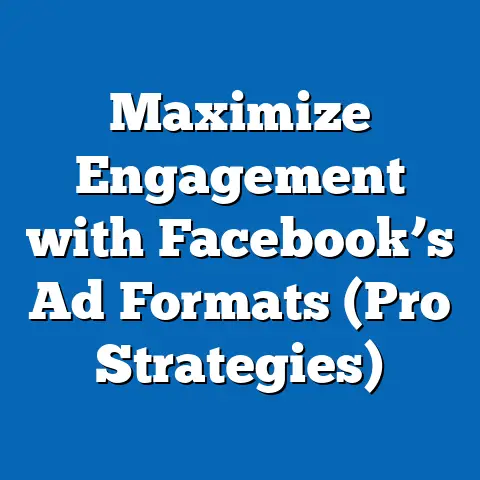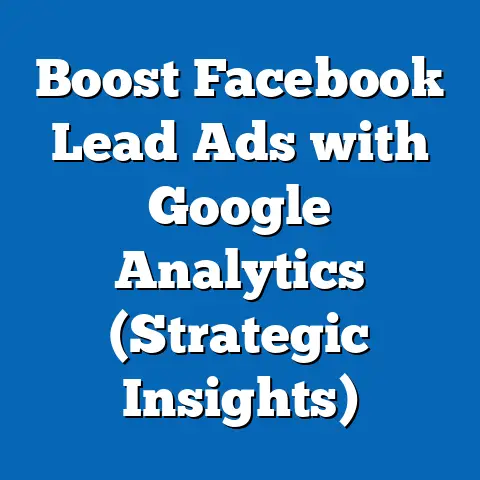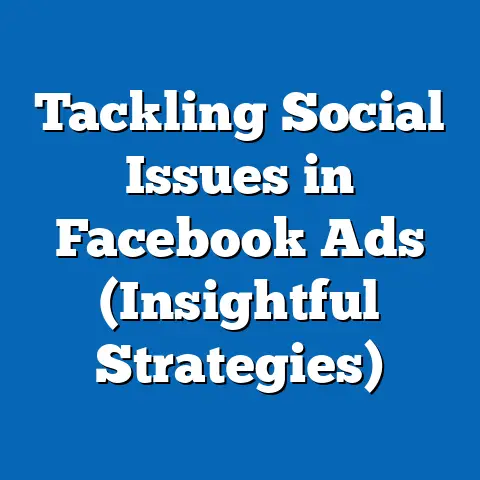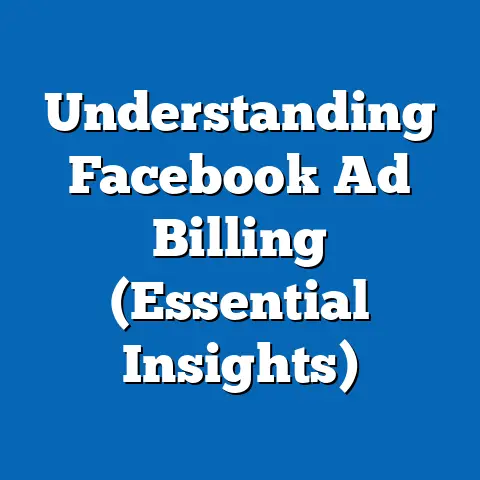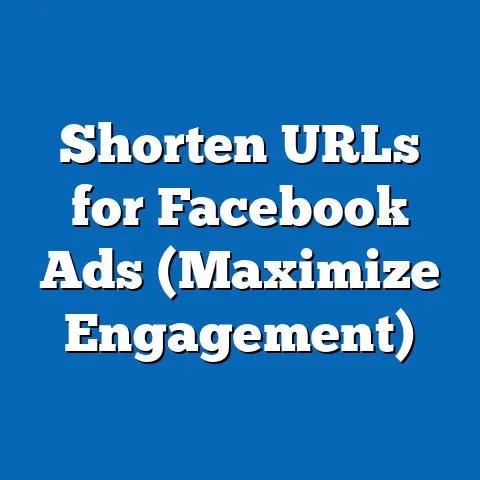Unlocking Display Links in Facebook Ads (Game-Changer Insights)
In the ever-evolving landscape of digital advertising, Facebook Ads have long been a cornerstone for businesses seeking to connect with their target audiences. Among the myriad features and tools offered by the platform, display links—a seemingly minor component of ad formatting—hold untapped potential that can transform campaign performance. Often overlooked, display links are the customizable URLs shown in an ad’s text, distinct from the actual destination URL, and they offer subtle yet powerful ways to enhance branding, trust, and click-through rates.
This article delves into the hidden benefits of display links in Facebook Ads, exploring their defining characteristics, historical context within digital marketing, and broader societal implications. By unlocking the strategic use of display links, advertisers can gain a competitive edge in a crowded digital space. We will analyze how this feature has evolved, the technological and cultural factors shaping its use, and its impact on consumer behavior and business outcomes.
Our exploration is grounded in data-driven insights, industry perspectives, and real-world applications, aiming to provide a comprehensive understanding of why display links are a game-changer. From small businesses to global brands, the implications of mastering this tool ripple across marketing strategies, economic outcomes, and even societal perceptions of digital trust. Let’s begin by uncovering the core advantages and characteristics of display links that make them indispensable in modern advertising.
Hidden Benefits of Display Links in Facebook Ads
Display links in Facebook Ads may appear as a small detail, but their impact on campaign success is significant. Unlike the destination URL, which directs users to the landing page, the display link is the visible text shown in the ad, often a shortened or branded version of the actual web address. This customization offers a unique opportunity to build trust and recognition with audiences.
One key hidden benefit is the enhancement of brand credibility. A display link that reflects the company’s name or a recognizable domain (e.g., “Nike.com” instead of a generic or suspicious-looking URL) reassures users about the legitimacy of the ad, reducing hesitation to click. Studies have shown that trust in digital ads is a critical factor in user engagement, with 81% of consumers stating they need to trust a brand before making a purchase (Edelman Trust Barometer, 2022).
Another advantage lies in improved user experience and memorability. A clean, concise display link aligns with the ad’s messaging, making it easier for users to recall the brand or product later. This subtle reinforcement of brand identity can lead to higher conversion rates over time, even if the immediate click doesn’t result in a sale.
Finally, display links provide a layer of strategic flexibility. Advertisers can tailor the visible URL to match campaign themes, promotions, or specific landing pages without altering the actual destination link. This adaptability allows for creative storytelling and targeted messaging, which are essential in capturing attention in a saturated ad environment.
Defining Characteristics of Display Links
At their core, display links are a formatting feature within Facebook Ads that allow advertisers to customize the visible URL text displayed beneath the ad’s headline or description. Unlike traditional URLs, which may be long, complex, or filled with tracking parameters, display links are designed to be user-friendly and aligned with branding goals. This distinction between appearance and functionality is what makes them unique.
A defining characteristic is their brevity and clarity. Facebook imposes character limits on display links, encouraging advertisers to keep them short and relevant, often reflecting the root domain or a key keyword. This constraint fosters a focus on impactful messaging.
Another characteristic is their role in transparency. While the actual destination URL may include tracking codes or redirects, the display link offers a simplified snapshot of where the user is headed, bridging the gap between technical necessity and user perception. This balance is critical in maintaining trust in an era where online scams and phishing attempts are prevalent.
Lastly, display links are inherently tied to the visual hierarchy of an ad. Positioned prominently, they influence how users interpret the ad’s legitimacy and relevance. Their design and wording can subtly affect emotional responses, making them a psychological tool as much as a technical one.
Historical Context: The Evolution of Digital Advertising and Display Links
To fully appreciate the significance of display links, it’s essential to understand their place within the broader history of digital advertising. The early days of online marketing in the late 1990s and early 2000s were marked by rudimentary banner ads and pop-ups, where URLs were often displayed in full, unedited form. These raw links, while functional, lacked aesthetic appeal and frequently appeared untrustworthy to users unfamiliar with the digital landscape.
The launch of Google AdWords in 2000 marked a turning point, introducing more structured ad formats and the concept of customized visible URLs to enhance user trust. This innovation laid the groundwork for platforms like Facebook, which entered the advertising space in 2007 with a focus on social engagement and targeted reach. Early Facebook Ads were simple, often mimicking organic posts, but as the platform grew, so did the sophistication of its ad tools.
Display links emerged as a feature in the 2010s, coinciding with a surge in mobile internet usage and the need for concise, visually appealing ad elements. During this period, consumer skepticism toward online ads grew due to high-profile data breaches and privacy scandals, such as the 2013 Target data breach and later the 2018 Cambridge Analytica controversy involving Facebook itself. Customizable display links became a way to counter this distrust by presenting familiar, branded URLs that reassured users.
This historical shift reflects broader societal trends, including the rise of digital literacy and the demand for transparency in online interactions. Display links, though a small feature, embody the industry’s response to these evolving expectations, balancing technical complexity with user-centric design. Their development also parallels the growing importance of mobile-first advertising, where screen real estate is limited, and every element of an ad must serve a purpose.
Societal Implications: Trust, Perception, and Digital Behavior
This impact on trust has broader implications for digital behavior. According to a 2021 Pew Research Center study, 64% of Americans express concern about the security of their online interactions, with younger generations like Gen Z being particularly wary due to their lifelong exposure to digital risks. Display links, when used effectively, can bridge this trust gap by aligning with familiar branding or clear messaging, encouraging safer online engagement.
Moreover, display links contribute to the normalization of branded digital experiences. As consumers become accustomed to seeing polished, recognizable URLs in ads, their expectations for professionalism in online marketing rise. This shift pressures businesses—especially small and medium-sized enterprises (SMEs)—to invest in cohesive branding strategies, leveling the playing field between large corporations and smaller players.
There are also cultural implications tied to regional differences in digital trust. In markets with high internet penetration but lower digital literacy, such as parts of Southeast Asia or Sub-Saharan Africa, display links can either build confidence or exacerbate skepticism if not localized properly. Advertisers must navigate these nuances to avoid alienating diverse audiences, highlighting the need for culturally sensitive marketing practices.
Technological and Economic Factors Shaping Display Link Usage
Additionally, advancements in ad tracking and analytics have influenced how display links are perceived. While the underlying destination URL often includes UTM parameters for tracking purposes, the display link masks this complexity, maintaining a clean user interface. This balance reflects the tension between data-driven marketing and user privacy concerns, a debate that continues to shape platform policies like Apple’s App Tracking Transparency (ATT) framework introduced in 2021.
Economically, display links offer a cost-effective way to enhance ad performance without requiring significant additional investment. For businesses operating on tight budgets, customizing a display link to reflect a campaign’s focus (e.g., “ShopNow.Brand.com”) can boost click-through rates without the need for expensive creative overhauls. This accessibility democratizes high-impact advertising strategies, allowing SMEs to compete with larger brands.
However, economic disparities also play a role in adoption rates. Companies in emerging markets may lack the resources or expertise to leverage display links effectively, perpetuating digital divides. As global ad spend continues to grow—projected to reach $740 billion by 2025 (eMarketer)—understanding and utilizing such features will become a competitive necessity, further widening gaps between digitally savvy and under-resourced businesses.
Cultural and Social Influences on Display Link Strategies
Cultural and social factors significantly influence how display links are crafted and received by audiences. In Western markets, where individualism and brand loyalty often drive consumer behavior, display links that emphasize recognizable company names or slogans tend to perform well. For instance, a display link like “Apple.com/Innovation” aligns with cultural values of personal expression and technological leadership.
In contrast, collectivist cultures in East Asia may respond better to display links that evoke community or shared values, such as “JoinUs.Brand.com.” These variations underscore the importance of cultural adaptation in global campaigns, as a one-size-fits-all approach risks alienating key demographics. Research by Hofstede Insights highlights that cultural dimensions like power distance and uncertainty avoidance directly impact trust in advertising, necessitating tailored strategies.
Social trends, such as the growing influence of social media activism, also shape display link usage. Consumers increasingly expect brands to align with social causes, and a display link like “SupportEquality.Brand.com” can signal a company’s values, resonating with socially conscious audiences like Millennials and Gen Z. However, such messaging must be authentic to avoid backlash, as seen in high-profile cases of “woke-washing” where brands face criticism for insincere social stances.
The diversity within generational cohorts adds another layer of complexity. While younger users may prioritize creativity and relevance in display links, older demographics like Baby Boomers often value clarity and simplicity, preferring straightforward URLs like “Brand.com/Shop.” Advertisers must balance these preferences to appeal to broad audiences without diluting their message.
Comparative Analysis: Display Links Across Platforms and Industries
While this article focuses on Facebook Ads, it’s worth comparing how display links function across other platforms and industries to highlight their unique value. On Google Ads, for instance, visible URLs are similarly customizable but are often tied to the root domain of the landing page, limiting creative freedom compared to Facebook’s more flexible approach. This distinction allows Facebook advertisers to experiment with thematic or promotional display links that don’t necessarily mirror the destination URL.
Twitter (now X) Ads, on the other hand, often embed links within shortened URLs due to character constraints, sacrificing branding for brevity. Instagram Ads, closely tied to Facebook’s infrastructure, share similar display link capabilities but prioritize visual content over text, reducing the prominence of the link itself. These platform-specific differences underscore Facebook’s unique position as a space where display links can play a starring role in ad design.
Across industries, the application of display links varies widely. E-commerce brands frequently use them to highlight specific products or sales (e.g., “Brand.com/BlackFriday”), capitalizing on urgency and relevance. In contrast, B2B companies may opt for trust-building display links like “Solutions.Company.com,” emphasizing credibility over immediacy. Nonprofits, meanwhile, often leverage emotional appeals with links like “DonateNow.Org,” aligning with their mission-driven messaging.
These variations illustrate that while display links are a universal tool, their impact depends on context. Advertisers must consider platform dynamics, industry norms, and audience expectations to maximize effectiveness, avoiding a blanket approach that overlooks critical nuances.
Nuances and Diversity in Display Link Effectiveness
It’s important to acknowledge that the impact of display links is not uniform across all campaigns or demographics. Factors such as audience digital literacy, cultural background, and device usage create variability in how links are perceived and acted upon. For instance, tech-savvy users may scrutinize display links for authenticity, while less experienced users might overlook them entirely, focusing instead on visuals or ad copy.
Geographic diversity also plays a role. In regions with limited internet access or slower connection speeds, users may hesitate to click on links that appear unfamiliar, regardless of branding efforts. Language barriers further complicate effectiveness, as a display link in English may alienate non-English-speaking audiences, even if the ad is translated.
Campaign objectives introduce additional nuances. Display links designed for brand awareness may prioritize memorability over clickability, using creative wording that doesn’t directly prompt action. Conversely, performance-driven campaigns focused on conversions may use action-oriented links like “BuyNow.Brand.com” to drive immediate results. Recognizing these differences is crucial for setting realistic expectations and measuring success.
Finally, the evolving nature of ad fatigue must be considered. As users are exposed to thousands of ads daily, even well-crafted display links can lose impact over time if overused or poorly targeted. Continuous testing and adaptation are necessary to maintain relevance in a dynamic digital environment.
Implications for Businesses, Consumers, and Society
The strategic use of display links in Facebook Ads carries far-reaching implications for various stakeholders. For businesses, mastering this feature can lead to improved campaign ROI, stronger brand identity, and deeper consumer trust. Small businesses, in particular, stand to gain by using display links to appear more professional and competitive without significant financial outlay.
However, the reliance on display links also introduces challenges. Companies must invest in ongoing education to keep pace with platform updates and best practices, as Meta frequently adjusts its ad policies. Missteps, such as using misleading display links, can damage reputation and invite regulatory scrutiny, especially in light of stricter global data protection laws like GDPR and CCPA.
For consumers, display links offer a clearer, more trustworthy digital experience when used responsibly. They can reduce the cognitive load of navigating online ads, making it easier to identify legitimate offers. Yet, the potential for misuse—such as disguising malicious URLs—remains a concern, emphasizing the need for user education on digital safety.
At a societal level, the widespread adoption of display links reflects broader trends toward personalization and transparency in technology. As digital interactions become more seamless, they shape expectations for how brands communicate, pushing industries toward greater accountability. This shift also highlights the digital divide, as access to sophisticated ad tools remains unevenly distributed across global markets.
In the workplace, the emphasis on display links underscores the growing importance of digital marketing skills. Professionals must adapt to data-driven strategies, blending creativity with technical know-how to craft effective campaigns. This evolution impacts hiring trends, with demand for social media specialists and data analysts rising steadily (LinkedIn Workforce Report, 2023).
Forward-Looking Insights: The Future of Display Links and Digital Advertising
Looking ahead, the role of display links in Facebook Ads is poised to evolve alongside broader technological and cultural shifts. The integration of artificial intelligence (AI) and machine learning into ad platforms could enable hyper-personalized display links, dynamically tailored to individual user preferences or browsing history. While promising, this raises ethical questions about privacy and consent, areas where regulation will likely intensify.
The rise of immersive technologies, such as augmented reality (AR) and virtual reality (VR), may also redefine how display links are presented. In a 3D ad environment, links might become interactive elements, blending seamlessly into virtual spaces. Meta’s investment in the metaverse suggests that such innovations are on the horizon, though their adoption will depend on user readiness and infrastructure development.
Economic uncertainties, including potential recessions and fluctuating ad budgets, will influence how businesses prioritize tools like display links. Cost-effective strategies will remain critical, ensuring that even resource-constrained advertisers can leverage small but impactful features. However, competition for user attention will intensify, requiring constant innovation to stand out.
Culturally, the growing emphasis on authenticity and social responsibility will shape display link strategies. Consumers will demand transparency, rejecting ads that appear deceptive or out of touch with societal values. Brands that align display links with genuine messaging will likely see sustained engagement, while others risk alienating their base.
Despite these trends, uncertainties remain. Regulatory changes, technological disruptions, and shifting user behaviors could alter the digital advertising landscape in unforeseen ways. Advertisers must remain agile, using data and experimentation to navigate this fluid environment. Display links, though a small piece of the puzzle, will continue to play a pivotal role in connecting brands with audiences, provided they are wielded with precision and foresight.
Conclusion: Harnessing the Game-Changing Potential of Display Links
Display links in Facebook Ads, often dismissed as a minor detail, emerge as a powerful tool for enhancing trust, engagement, and brand identity. Their hidden benefits—from building credibility to offering strategic flexibility—make them a game-changer in the competitive world of digital advertising. By understanding their defining characteristics, historical evolution, and societal implications, businesses can unlock their full potential to drive meaningful results.
This analysis has highlighted the interplay of technological, economic, cultural, and social factors that shape display link effectiveness. It has also emphasized the importance of nuance, recognizing the diversity of audiences and contexts in which ads operate. From small businesses to global corporations, the implications of mastering display links extend to consumer trust, workplace skills, and broader digital trends.
As we look to the future, the role of display links will likely grow in complexity and significance, shaped by emerging technologies and evolving expectations. While uncertainties persist, one thing is clear: advertisers who embrace this feature with creativity and responsibility stand to gain a lasting edge. In a digital landscape defined by rapid change, display links offer a subtle yet profound way to connect, persuade, and inspire—a true game-changer for those willing to unlock their potential.

